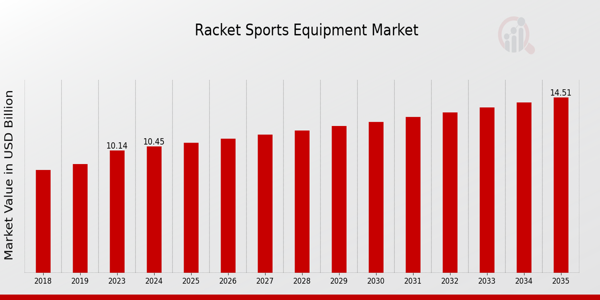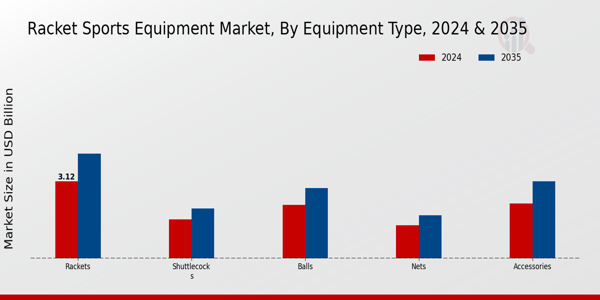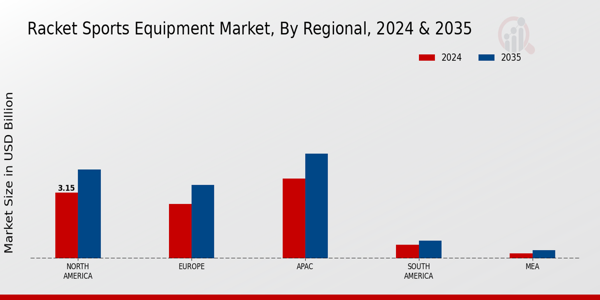Global Racket Sports Equipment Market Overview
As per MRFR analysis, the Racket Sports Equipment Market Size was estimated at 10.14 (USD Billion) in 2023.
The Racket Sports Equipment Market is expected to grow from 10.45 (USD Billion) in 2024 to 14.5 (USD Billion) by 2035. The Racket Sports Equipment Market CAGR (growth rate) is expected to be around 3.03% during the forecast period (2025 - 2035).
Key Racket Sports Equipment Market Trends Highlighted
The growing popularity of sports like squash, badminton, and tennis is the main factor propelling the remarkable rise of the Racket Sports Equipment Market. Two important factors are the emphasis on outdoor leisure activities and consumers' growing health consciousness.
Racket sports are becoming more popular as people become more conscious of the advantages of physical fitness.
Additionally, the increasing popularity of celebrity endorsements and professional sporting events is raising brand awareness and promoting involvement in these sports. Innovative product development offers opportunities, such as the creation of lightweight materials and ergonomic designs that improve user comfort and performance.
In order to satisfy consumers who care about the environment, eco-friendly equipment composed of recyclable materials is emerging as a result of the sustainability trend. Furthermore, producers may now reach a larger audience thanks to the growth of e-commerce and online platforms, which facilitates fans' access to a variety of product offerings.
Modern trends show a shift towards integrating technology into sports equipment, such as smart rackets that offer performance tracking and analysis.
This aligns with the lifestyle of tech-savvy consumers looking for integration of technology in their sporting activities. Moreover, there is an increasing focus on women's participation in racket sports, reflected in specialized equipment and grassroots programs aimed at promoting gender equality in sports.
The market also sees an emphasis on community-based events and youth engagement programs, which further boosts interest in racket sports. As the landscape of the sports industry evolves, brands and manufacturers are aligning their strategies to meet changing consumer expectations, thereby setting the stage for sustained growth in the market.

Racket Sports Equipment Market Drivers
Rising Popularity of Racket Sports
The Racket Sports Equipment Market is currently experiencing significant growth driven by the rising popularity of racket sports such as tennis, badminton, squash, and pickleball. As more individuals are drawn to these sports for their physical benefits and social aspects, participation rates have surged.
The increasing number of recreational players, along with professional leagues and events gaining traction across various demographics, has substantially boosted the demand for racket sports equipment.
With more people recognizing the health advantages associated with engaging in racket sports, including enhanced cardiovascular fitness, improved flexibility, and better coordination, the interest in these sports continues to rise.
Additionally, the evolution of communication platforms and social media has enabled enthusiasts to connect easily, share experiences, and foster a sense of community around racket sports. Manufacturers are investing in promotional campaigns, thus enhancing the visibility of racket sports and encouraging more individuals to participate.
Schools and local organizations are also integrating racket sports into their physical education curriculums, introducing children to the activity from an early age. As these young players grow, they are likely to sustain their interest in racket sports, ultimately contributing to lifelong participation.
Overall, the increasing visibility and accessibility of racket sports is creating a favorable environment for the growth of the Racket Sports Equipment Market.
Technological Advancements in Equipment
Technological advancements in racket sports equipment play a pivotal role in driving the Racket Sports Equipment Market forward.
Innovations in materials, design, and manufacturing processes are leading to the introduction of high-performance products that enhance player experience and performance. For instance, the development of lightweight and durable materials has resulted in superior rackets that improve maneuverability and control.
Manufacturers are also leveraging advanced technology to create equipment tailored to different skill levels, ensuring accessibility for both amateurs and professionals.
Additionally, the integration of smart technologies in equipment, such as sensors that provide real-time performance data, is gaining traction among tech-savvy players. These advancements are not only enhancing gameplay but also attracting more players to the sport, contributing to continued market growth.
Growth of Indoor Sports Facilities
The expansion of indoor sports facilities is significantly influencing the Racket Sports Equipment Market. With the increase in urbanization, more individuals are seeking indoor spaces to engage in racket sports, especially in regions with unfavorable weather conditions.
The rise of multi-sport complexes that offer various racket sports options is making these activities more accessible to a wider audience. This surge in facilities encourages more people to try racket sports, thereby increasing the demand for associated equipment.
Furthermore, the focus on building community-centered sports complexes enhances the social aspect of racket sports, promoting a culture of fitness and recreation.
Racket Sports Equipment Market Segment Insights
Racket Sports Equipment Market Equipment Type Insights
The Racket Sports Equipment Market was segmented into various equipment types, showcasing a diverse assortment that caters to enthusiasts across different racket sports.
In 2024, the overall market contributed significantly to the economy, with Equipment Type playing a crucial role in this valuation. The segment attracted a considerable share of the total market revenue, which reached 10.45 USD Billion.
Rackets held a notable position within this segment, valued at 3.12 USD Billion in 2024 and anticipated to rise to 4.25 USD Billion by 2035, thereby dominating the market as a major contributor. The popularity of racket sports has led to a consistent demand for high-quality rackets among both recreational and professional players, indicating their integral role in the overall market dynamics.
Shuttlecocks, another vital category within the Equipment Type segment, contributed significantly to the sector with a valuation of 1.58 USD Billion in 2024 and projected to grow to 2.03 USD Billion by 2035. As a key component in badminton, the demand for shuttlecocks is driven by the growing popularity of the sport across various demographics, which allows it to maintain a solid footing in the market.
Similarly, Balls, which were valued at 2.18 USD Billion in 2024 and are expected to grow to approximately 2.85 USD Billion by 2035, captured a significant interest due to their use in sports such as tennis and squash, further emphasizing the diversity within this Equipment Type segment.
Moreover, in the realm of Nets, the valuation was at 1.35 USD Billion in 2024, expanding to 1.75 USD Billion by 2035. Nets were crucial for establishing play areas and defining boundaries in racket sports, which highlights their importance for both practice and competition.
Finally, Accessories, encompassing a variety of products that enhanced the playing experience, reached a valuation of 2.22 USD Billion in 2024, increasing to 3.12 USD Billion in 2035. This segment included items such as grips, bags, and protective gear, contributing to the overall appeal of racket sports and the supporting market for players looking to enhance their performance.
As the Racket Sports Equipment Market continues to evolve, factors such as lifestyle changes, increasing awareness about fitness, and the growing trend of participating in racket sports contribute positively to the market's growth trajectory.
Understanding the specific characteristics of each Equipment Type allows stakeholders to seize opportunities and tackle potential challenges within this competitive landscape. The blend of growth drivers like innovation, accessibility of equipment, and the rising number of participants across various age groups creates promising potential for expansion in the future.
The Racket Sports Equipment Market data provided a clear perspective on how market growth remains intertwined with the popularity and advancements of racket sports, solidifying its various equipment types as essential elements in the ongoing success of this industry.

Racket Sports Equipment Market Sport Category Insights
The Racket Sports Equipment Market is a dynamic sector within the sports equipment industry. The Sports Category includes various activities such as badminton, tennis, squash, and pickleball, each contributing uniquely to market dynamics.
Tennis has emerged as a prominent segment, largely due to its global popularity and numerous professional tournaments, attracting a vast audience and increasing participation rates. Badminton, known for its fast-paced gameplay and accessibility, has seen significant engagement, particularly in Asia, which serves as a major hub for the sport.
Squash, while niche, maintains a loyal following and benefits from growing health-awareness trends, encouraging new players to join. Pickleball is rapidly gaining traction, especially in North America, appealing to a broad demographic for its social and fitness aspects.
The Racket Sports Equipment Market statistics indicate that the growth drivers for this segment include rising fitness consciousness, the popularity of racquet sports as competitive options, and increasing investment in sports infrastructure. However, challenges such as competition from alternative sports and changing consumer preferences pose hurdles for market players.
The market growth presents opportunities for innovation and product diversification, with manufacturers focusing on enhancing performance and user experience.
Racket Sports Equipment Market Material Insights
The Racket Sports Equipment Market, particularly within the Material segment, has shown robust growth and diversification. The market segmentation includes notable materials such as Graphite, Aluminum, Wood, and Synthetic options, each contributing uniquely to market dynamics.
Graphite, recognized for its strength and lightweight properties, has become the preferred choice among professional players, while Aluminum offers durability at a cost-effective price, appealing to recreational players.
Wood, though traditional, continues to attract enthusiasts and collectors, preserving its niche despite the rise of newer materials. Synthetic materials have gained popularity due to their advanced technology and performance features, catering to a broader audience.
These materials cater to preferences ranging from performance needs to budget considerations, driving the market growth. The diverse material options allow for customization and accessibility, making the Racket Sports Equipment Market adaptable to player requirements and preferences.
Understanding these trends enables stakeholders to navigate opportunities and challenges effectively.
Racket Sports Equipment Market Distribution Channel Insights
The Distribution Channel segment of the Racket Sports Equipment Market plays a crucial role in reaching consumers effectively and enhancing market growth.
Online Retail has gained significant traction, catering to the growing preference for e-commerce shopping, which offers convenience and a vast selection. Specialty Stores are essential as they provide expert advice and personalized service, capturing the interest of avid players looking for specific equipment.
Hypermarkets offer a wide range of products, making them a popular choice for consumers seeking one-stop shopping experiences. Sporting Goods Stores remain significant, acting as focal points for brand engagement and community events, which help foster customer loyalty and enhance the brand's visibility in the market.
The combination of these channels reflects the evolving purchasing behaviors of consumers and the importance of accessibility in the Racket Sports Equipment Market. Understanding these dynamics is vital for stakeholders to strategize their market positioning effectively.
Racket Sports Equipment Market Regional Insights
The Regional analysis of the Racket Sports Equipment Market highlighted a diverse landscape, with North America leading the valuation at 3.15 USD Billion in 2024, expected to grow to 4.25 USD Billion by 2035, showcasing its majority holding.
Europe's market stood at 2.6 USD Billion in 2024 and is projected to reach 3.5 USD Billion by 2035, indicating its significant role in the industry. APAC followed closely with a valuation of 3.8 USD Billion in 2024, progressing to 5.0 USD Billion in 2035, marking it as a notable growth area owing to rising participation in racket sports.
South America, while smaller, is valued at 0.65 USD Billion in 2024, increasing to 0.85 USD Billion by 2035, reflecting the region's developing interest in sports activities. The MEA region stood at 0.25 USD Billion in 2024, with growth to 0.4 USD Billion by 2035, indicating a nascent but growing market.
The varying market dynamics amongst these regions presented opportunities and challenges, from North America's established market to APAC's rapid expansions, all contributing to the evolving landscape of the Racket Sports Equipment Market revenue and its segmentation.
Emerging trends such as increased health awareness and the rise of sports participation globally are likely to fuel growth across these regions, defining the future trajectory of the Racket Sports Equipment Market.

Racket Sports Equipment Market Key Players and Competitive Insights
The competitive insights of the Racket Sports Equipment Market reveal a dynamic environment characterized by diverse product offerings, evolving consumer preferences, and robust innovation. As the market continues to expand, numerous players focus on enhancing their technological capabilities and establishing brand loyalty through strategic partnerships and marketing initiatives.
The market is segmented into various categories, such as badminton, tennis, squash, and racquetball, making it imperative for companies to distinguish themselves through quality, performance, and design. The ongoing trend of sports participation globally, including at grassroots and professional levels, contributes significantly to the growth of this sector, prompting companies to invest in research and development to cater to changing consumer needs.
Gamma holds a strong position within the Racket Sports Equipment Market, recognized for its commitment to producing high-performance racket technologies that cater to both amateur and professional players. One of Gamma's notable strengths lies in its innovative approach to product development, constantly introducing new materials and designs that enhance player performance and comfort.
The company has built a reputation for providing extensive customization options, allowing players to select racket specifications that align with their unique playing styles.
Moreover, Gamma's marketing strategy emphasizes educating consumers about the benefits of their products, thereby fostering a loyal customer base. Their robust distribution network ensures visibility and product availability across various channels, enhancing market penetration and reinforcing their leadership in the racket sports segment.
Slazenger, another pivotal player in the Racket Sports Equipment Market, has cultivated a legacy of quality and performance that resonates with sports enthusiasts. Known for its heritage and longstanding reputation within racket sports, Slazenger excels in delivering products that combine tradition with modern technology.
The company leverages its brand equity to capture diverse market segments, appealing not only to seasoned professionals but also to newcomers in the sport. Slazenger's strengths encompass an extensive portfolio of products that include tennis rackets and accessories recognized for their durability and superior craftsmanship.
The brand actively engages in sponsorship of tournaments and associations, reinforcing its connection to the sports community and enhancing its visibility among consumers. With a focus on maintaining high standards of quality and service, Slazenger continues to solidify its presence in the competitive landscape of racket sports, contributing to the overall growth of the market.
Key Companies in the Racket Sports Equipment Market Include
Racket Sports Equipment Market Developments
Recent developments in the Racket Sports Equipment Market indicate a significant surge in consumer interest, particularly towards leading brands like Wilson, Head, and Yonex. These companies have reported an increase in product demand due to rising participation in sports such as tennis and badminton.
Innovations in technology, lightweight materials, and ergonomic designs have also enhanced product offerings, appealing to both amateur and professional players. The health and wellness trend has further propelled market growth, with brands like Adidas introducing new fitness-focused racket products.
In terms of mergers and acquisitions, there have been recent discussions among companies like Dunlop and Tecnifibre aimed at expanding their portfolios and market reach. This consolidation trend may lead to a stronger competitive landscape, fostering innovation and improved customer experiences.
Additionally, the financial reports indicate that brands such as Babolat have seen an uptick in market valuation, contributing positively to the overall market dynamics. Companies are increasingly focusing on sustainability practices, with several brands, including Prince and Gamma, investing in eco-friendly materials, further shaping the market's future direction.
| Report Attribute/Metric |
Details |
| Market Size 2023 |
10.14(USD Billion) |
| Market Size 2024 |
10.45(USD Billion) |
| Market Size 2035 |
14.5(USD Billion) |
| Compound Annual Growth Rate (CAGR) |
3.03% (2025 - 2035) |
| Report Coverage |
Revenue Forecast, Competitive Landscape, Growth Factors, and Trends |
| Base Year |
2024 |
| Market Forecast Period |
2025 - 2035 |
| Historical Data |
2019 - 2024 |
| Market Forecast Units |
USD Billion |
| Key Companies Profiled |
Gamma, Slazenger, Tretorn, Prince, ProKennex, Adidas, Nike, Head, Wilson, Dunlop, Karakal, Babolat, Tecnifibre, Yonex, Volkl |
| Segments Covered |
Equipment Type, Sport Category, Material, Distribution Channel, Regional |
| Key Market Opportunities |
Rising health consciousness globally, Increasing youth participation in sports, Growth in e-commerce for sports gear, Technological advancements in equipment, and Sustainable materials in manufacturing. |
| Key Market Dynamics |
Rising participation in sports, Increasing fitness awareness, Technological advancements in equipment, Growth of online retailing, Popularity of professional sports events |
| Countries Covered |
North America, Europe, APAC, South America, MEA |
Frequently Asked Questions (FAQ) :
The Racket Sports Equipment Market was valued at 10.45 USD Billion in 2024.
In 2035, the market is projected to reach a value of 14.5 USD Billion.
The expected CAGR for the market from 2025 to 2035 is 3.03%.
North America dominated the market with a value of 3.15 USD Billion in 2024.
The APAC region is projected to have a market size of 5.0 USD Billion in 2035.
Key players in the market include Gamma, Slazenger, Prince, Adidas, and Wilson, among others.
The market size for Rackets was 3.12 USD Billion in 2024.
The market size for Shuttlecocks is projected to grow from 1.58 USD Billion in 2024 to 2.03 USD Billion in 2035.
Challenges may include fluctuating material costs and competition from other sports equipment markets.
Key growth drivers include increasing participation in racket sports and rising consumer awareness regarding fitness.

















